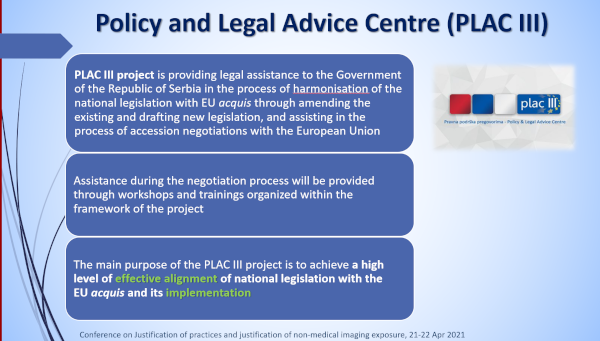24 April 2021.
The participants in the international conference Workshop on Justification of practices in the medical field and non-medical imaging exposures on 21 and 22 April 2021 via Zoom application were the representatives of the European Commission, the International Atomic Energy Agency, the United Nations Scientific Committee on the Effects of Atomic Radiation (UNSCEAR), the International Commission on Radiological Protection (ICRP), European professional organizations, and numerous national and European experts.
The conference was organized by Policy and Legal Advice Centre (PLAC III)and Serbian Radiation and Nuclear Safety and Security Directorate (SRBATOM).
In his opening address, Andrej Engelman, team leader of PLAC III project pointed out that the conference themes relate to Chapter 15 in Serbia’s EU accession negotiations, which is one of 11 Chapters this EU project covers.
Jasminka Joksic, EU Integration Adviser at Serbian Radiation and Nuclear Safety and Security Directorate opened the conference by pointing out that the Directorate is a part of a Negotiation Group for Chapter 15, and that within PLAC III project from 2019 to July this year there has been a plan for seven activities aiming at further harmonization with EU acquis. She expressed her belief that this conference would be an outstanding event to look into the fundamental aspects of the principle and process of justification including deliberate exposure of humans for medical and non-medical imaging purposes, and consumer products practices as well. She also announced that the conference would be an opportunity to look at some specific aspects such as radiological imaging of asymptomatic patients, children and pregnant women, as well as an opportunity to discuss the possibilities of developing tools such as imaging referral guidelines, clinical audit, and the role of national and international professional societies.
On Day 1 of the conference, the participants were first addressed by the representatives of the European Commission and relevant international institutions and organizations. This was followed by the examples of practical experience of EU Member States and Serbia.
Georgi Simeonov, Directorate-General for Energy, said that 27 EU Member States, together with the Great Britain, have transposed the Directive 2013/59 Euratom into their legislation, and that the Commission, due to incomplete transposition, has initiated 20 investigation procedures. He also said that the priority programme of the European Commission is to initiate the European Initiative on Quality and Safety of medical applications of ionizing radiation, which commenced this year.
The representative of the International Atomic Energy Agency (IAEA), Jenia Vassileva explained the IAEA’s role in the development of basic safety standards in case of medical exposure to ionizing radiation. Vassileva added that, even though these IAEA standards are non-binding, the Member States can adopt them. She emphasized that these standards are binding in case of operations supported by the IAEA, and for those countries that are planning to join any projects with the Agency. “The IAEA supports all its Member States in the implementation of standards by means of trainings and technical cooperation (TC), and Serbia is participating in regional TC projects”, she added.
Ferid Shannoun, the representative of the United Nations Scientific Committee on the Effects of Atomic Radiation (UNSCEAR) as the institution that, among other things, deals with data collation and ionizing radiation exposure evaluation, emphasized that the main objective of such an evaluation is to assess the global levels of the exposure of patients, occupationally exposed persons and the public, as well as to identify the trends in practice.
“The International Commission on Radiological Protection (ICRP), as an independent body, published 24 publications on radiological procedures in medicine”, said the organization’s representative Kimberly Applegate. She also pointed to the research conducted in the USA in 2019 that indicated that one third of the overall medical procedures were not justified, and underlined the hazards stemming from the high cumulative doses received this way.
The representatives of Slovenia, Greece and Lithuania shared their views on the justification of non-medical imaging radiation exposure. The representatives of Serbian Radiation and Nuclear Safety and Security Directorate (SRBATOM), Jasminka Joksic and Marijana Balin-Kovacevic spoke on Serbian practical experience on human exposure to non-medical imaging radiation. Milan Vujovic, Head of Radiation Practices and Nuclear Activities Control Division gave the overview of practices involving consumer products and non-medical imaging equipment in Serbia, and presented practical examples and practical experience within the regulatory control.
Day 2 of the conference was devoted to the analysis of the roles of professional organizations, and practices in Serbia and EU Member States in the field of medical exposure. The representatives of the European Federation of Organizations for Medical Physics (EFOMP), the European Association of Nuclear Medicine (EANM), the European Society for Radiotherapy and Oncology (ESTRO), the European Coordination Committee of the Radiological, Electromedical and Healthcare IT Industry (COCIR) and the European Society of Radiology (ESR) took part in this segment of the event. Nebojsa Jokic, Head of the Department of Health Care at the Ministry of Health spoke on medical imaging exposure practices. The representatives of Slovenia, Croatia, Lithuania and Greece presented practical experience of their countries in this field as well.
Stephen Evans, Senior Non-Key Expert (SNKE), PLAC III, presented the results of the study conducted in the EU Member States which showed that the relevant Directive was, for the most part, successfully transposed into the legislation of these countries. He said that in case of justification of medical exposure to ionizing radiation in 60% cases, the Directive requirements had already been incorporated in the national legislation, and in order to increase this percentage, it is necessary to organize interdisciplinary teamwork for health care workers.
The conference gathered 50 participants from European countries and Serbia, the representatives of a great number of national institutions, organizations and professional associations in this field.

